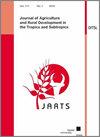Distribution of Alternaria leaf blight of sunflowers caused by Alternaria alternata in South Africa
Q3 Social Sciences
Journal of Agriculture and Rural Development in the Tropics and Subtropics
Pub Date : 2019-11-07
DOI:10.17170/KOBRA-20190613558
引用次数: 5
Abstract
Alternaria leaf blight (ALB) has been shown in recent years to be one of the major potential disease threats of sunflower capable of causing yield losses in all major production areas. The aim of this study was to determine the causal agent, prevalence and geographical distribution of ALB in the major sunflower production areas of South Africa. Surveys were conducted during 2012/13, 2013/14 and 2014/15 growing seasons at commercial sunflower production fields and at commercial cultivar trials. In the three growing seasons, twenty-nine sunflower commercial production sites were surveyed for ALB disease severity. Furthermore, four cultivars (AGSUN8251, PHB65A25, SY4200 and PAN7049) were surveyed for ALB during cultivar trials in a total of 25 localities during the three growing seasons. The plants were surveyed between 90 to 120 days after planting and leaves showing ALB symptoms were collected. Alternaria alternata was identified as the primary disease-causing organism of ALB in all the fields. Wesselsbron consistently had the lowest ALB disease severity during the 2013/14 and 2014/15 growing seasons, whereas Potchefstroom had the highest disease severity in all three growing seasons. Pearson’s correlation coefficient was greatest for temperature (r=0.6 in 2012/13, r=0.71 in 2013/14 and r=0.84 in 2014/15) and disease severity in all the growing seasons. Information about the distribution of sunflower diseases is important and this survey demonstrated that A. alternata is widespread across sunflower production areas in South Africa and may result in potential yield losses.由链格孢引起的向日葵链格孢叶枯病在南非的分布
近年来,链格孢叶枯病(ALB)已被证明是向日葵的主要潜在疾病威胁之一,能够在所有主要产区造成产量损失。本研究的目的是确定南非主要向日葵产区ALB的病因、流行率和地理分布。调查于2012/13、2013/14和2014/15生长季节在商业向日葵生产场地和商业品种试验中进行。在三个生长季节,对二十九个向日葵商业生产点进行了ALB疾病严重程度调查。此外,在三个生长季节的总共25个地方进行的品种试验中,对四个品种(AGSUN8251、PHB65A25、SY4200和PAN7049)的ALB进行了调查。在种植后90至120天对植物进行调查,并收集表现出ALB症状的叶子。Alternaria alternata是ALB的主要致病菌。在2013/14和2014/15生长季节,Wesselsbron的ALB疾病严重程度始终最低,而Potchefstroom在所有三个生长季节的疾病严重程度最高。在所有生长季节,温度和疾病严重程度的Pearson相关系数最大(2012/13年为0.6,2013/14年为0.71,2014/15年为0.84)。关于向日葵病害分布的信息很重要,这项调查表明,交流A.alternata在南非向日葵产区广泛分布,可能导致潜在的产量损失。
本文章由计算机程序翻译,如有差异,请以英文原文为准。
求助全文
约1分钟内获得全文
求助全文
来源期刊
CiteScore
2.30
自引率
0.00%
发文量
0
审稿时长
>36 weeks
期刊介绍:
The Journal of Agriculture and Rural Development in the Tropics and Subtropics publishes papers dealing with original research and review papers in the fields of plant production, animal nutrition and animal husbandry, soil science, rural economy and farm management, forestry and forest economy, veterinary hygiene and protection against epidemics.

 求助内容:
求助内容: 应助结果提醒方式:
应助结果提醒方式:


